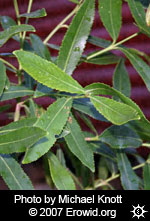Khat
Basics
DESCRIPTION #
Khat (Catha edulis, family: Celastraceae) is an evergreen shrub probably native to Ethiopia, although today it grows and is cultivated in East and South Africa, the Middle East, and Central Asia. It usually grows 3-5 meters tall and has tough, waxy, green leaves with serrated edges that darken in color as the plant matures. The fresh leaves, twigs, and buds have been ingested for centuries as a mild stimulant and euphoriant. It is viewed in parts of the Muslim world as an acceptable alernative to alcohol, though its use is prohibited in the United States and parts of Europe.
[ Main Khat Vault ]
Dose #
Fresh khat leaves are generally chewed in large quids for ten minutes or more. While chewing, the juices are held in the mouth and then swallowed and the chewed leaves are spit out. Khat may be chewed continuously for many hours at a time.
Price #
Price Summary Needed.
The khat plant is not specifically scheduled in the United States, but the leaves contain cathine, which is listed in Schedule IV and fresh leaves contain cathinone, which is Schedule I.
Chemistry #
The primary effects of khat are attributed to the chemicals cathinone and cathine. After the leaves are harvested, cathinone rapidly breaks down into cathine and the leaves are only mildly active more than a few days after being picked.
Pharmacology #
Cathinone produces its stimulant effects by releasing catecholamines from presynaptic storage sites. When khat leaves are chewed, absorption of cathinone through the oral mucosa is slow with peak plasma at about 2 hours, and an elimination half-life of approximately 4 hours.
Production #
Khat is widely cultivated for human consumption in Africa and the Middle East, particularly Yemen. In some regions it is a major cash crop, and the plant is one of Ethiopia's top exports.
Khat appears to be native to Ethipoia. According to folk history its effects were first discovered when goats were seen chewing its leaves and becoming frisky. The earliest known mention of khat is in a medical text from 1065.
Terminology / Slang #
The Substance:
Khat; Catha edulis; Kat; Qat; Chat; Miraa; Quaadka.
The Experience:
No common terms known.
EFFECTS #
Because the primary stimulant in khat degrades rapidly once the leaves are picked, the effects of khat depend greatly on the freshness of the plant material as well as on the amount chewed, and the duration of chewing. Khat is sometimes chewed continuously in sessions lasting up to several hours, and the effects intensify and plateau over the first couple of hours. The experience of khat chewing is often compared to other stimulants, similar to a strong dose of caffeine or a low dose of cocaine. Commonly reported effects include an increase in energy and alertness, increased physical endurance, mild euphoria, increased talkativeness, and cheerful mood. Physiological effects include increased heart rate, blood pressure, and wakefulness.
Onset #
When chewed, the effects of khat come on gradually. The onset may range between two and thirty minutes, depending on the amount chewed and the freshness of the leaves.
Duration #
Effects may persist from half an hour to a few hours after chewing stops.
Visual Effects #
Visuals Summary Needed.
PROBLEMS #
Khat use may cause people to become irritable or manic. Longterm use is associated with headaches, anorexia, insomnia, and stomach discomfort, and may cause reproductive problems in humans such as decreased sperm count. There are a few documented cases of khat-induced psychosis among chronic, heavy users. Khat use may lead to dependency problems.
Contraindications #
Contraindications Summary Needed.
Addiction Potential #
Cathinone is chemically and pharmacologically similar to amphetamine, raising questions about the addiction liability of khat chewing. Good data does not exist, but animal research suggests that khat use may lead to physical dependence similar to other stimulants. Khat dependence likely resembles caffeine dependence more than than cocaine or opiate dependence. Chewing leaves makes cathinone avaiable to the brain only gradually, and as a rule of thumb gradual administration leads to less addiction. However, daily chewing of large amounts of khat may lead to physical dependence.
Long Term Health Problems #
Long Term Health Problems Summary Needed.
Risk of Death #
Risk of Death Summary Needed.
CAUTION & DISCLAIMER #
Erowid Basics pages are summaries of data gathered from site visitors, government documents, books, websites, and other resources. We do our best to keep this information correct and up-to-date, but the field is complex and constantly changing. Information should always be verified through multiple sources.



